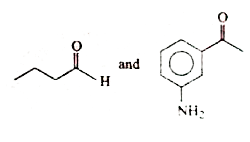A mixture of two organic compound gives red coloured precipitate with cuprous chloride and silver mirror on heating with Zn and NH4Cl followed by AgNO3+NH4OH solution. The mixture contains :




The correct Answer is:A
To solve the question regarding the mixture of two organic compounds that gives a red-colored precipitate with cuprous chloride and a silver mirror on heating with zinc and ammonium chloride followed by AgNO3 + NH4OH solution, we can follow these steps:
1. Identify the Reactions:
- The red-colored precipitate with cuprous chloride indicates the presence of a reducing sugar or an aldehyde, as cuprous chloride (CuCl) reacts with aldehydes to form a red precipitate of cuprous oxide (Cu2O).
- The formation of a silver mirror upon heating with zinc and ammonium chloride suggests the presence of an aldehyde, as this is a characteristic reaction of the Tollens' test.
2. Determine the Functional Groups:
- Since the silver mirror test is positive, we can conclude that at least one of the compounds in the mixture is an aldehyde.
- The reaction with zinc and ammonium chloride can reduce nitro groups (NO2) to amine groups (NH2). Therefore, one of the compounds must also contain a nitro group.
3. Analyze the Options:
- We need to find a combination of compounds where one is an aldehyde and the other is a nitro compound.
- Review the provided options:
- Check for the presence of an aldehyde group (–CHO) and a nitro group (–NO2) in each option.
4. Eliminate Incorrect Options:
- If an option does not contain an aldehyde, it can be eliminated.
- If an option contains an amine but not a nitro group, it can also be eliminated.
5. Select the Correct Option:
- After analyzing the options, the correct combination would be one compound with an aldehyde group and another with a nitro group.
- The option that fits this criterion is the one that contains both an aldehyde and a nitro group.
Conclusion:
- The correct answer is Option C, which contains one aldehyde and one nitro compound.
- The red-colored precipitate with cuprous chloride indicates the presence of a reducing sugar or an aldehyde, as cuprous chloride (CuCl) reacts with aldehydes to form a red precipitate of cuprous oxide (Cu2O).
- The formation of a silver mirror upon heating with zinc and ammonium chloride suggests the presence of an aldehyde, as this is a characteristic reaction of the Tollens' test.
- Since the silver mirror test is positive, we can conclude that at least one of the compounds in the mixture is an aldehyde.
- The reaction with zinc and ammonium chloride can reduce nitro groups (NO2) to amine groups (NH2). Therefore, one of the compounds must also contain a nitro group.
- We need to find a combination of compounds where one is an aldehyde and the other is a nitro compound.
- Review the provided options:
- Check for the presence of an aldehyde group (–CHO) and a nitro group (–NO2) in each option.
- If an option does not contain an aldehyde, it can be eliminated.
- If an option contains an amine but not a nitro group, it can also be eliminated.
- After analyzing the options, the correct combination would be one compound with an aldehyde group and another with a nitro group.
- The option that fits this criterion is the one that contains both an aldehyde and a nitro group.
- The correct answer is Option C, which contains one aldehyde and one nitro compound.
Similar Questions
Knowledge Check
- Question 1 - Select One
On heating a mixture of NH4Cl and KNO2, we get
ANH4NO3BKNH4(NO3)2CN2DNO
Which of the following compounds gives red ppt with Cu2Cl2/NH4OH ?
View SolutionA white, sublimable inorganic substance gives a brown precipitate on treatment with nessler's reagent and a whiite precipitate (soluble in NH3) with ann AgNO3 solution. The substance is :
View SolutionWhich of the following pairs of cations can be separated by adding NH4Cl and NH4OH to the mixture?
View SolutionWhen NH4Cl is added to a solution of NH4OH:
View SolutionAmongst the following, the compound not soluble in excess of NH4OH solution is:
View SolutionWhich of the following pairs of cations cannot be separated by adding NH4Cl and NH4OH to the mixture and then passing H2S through it?
View SolutionWhich of the following pairs of cations cannot be separated by adding NH4Cl and NH4OH to the mixture and then passing H2S through it?
View Solution
